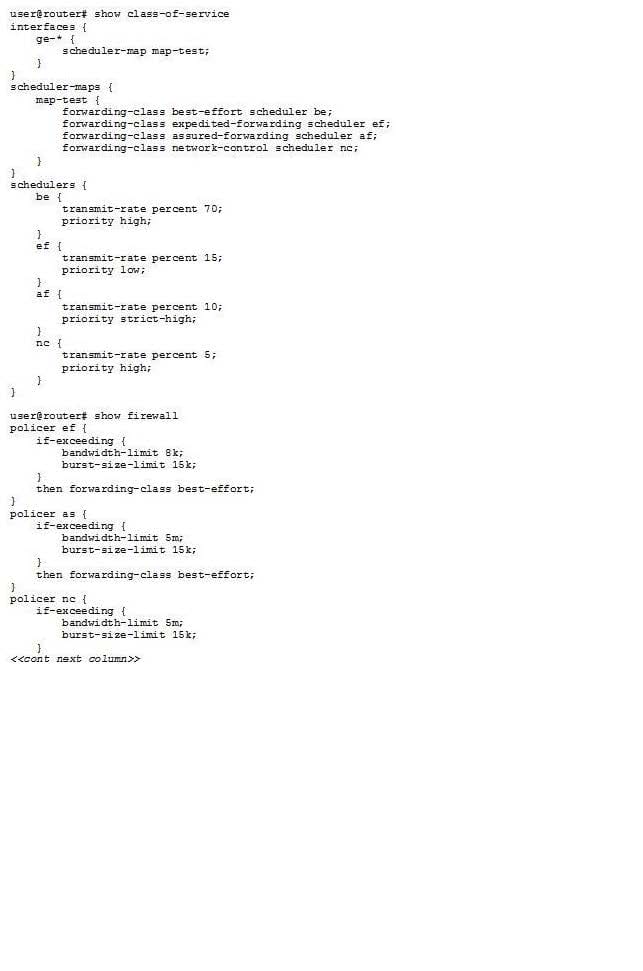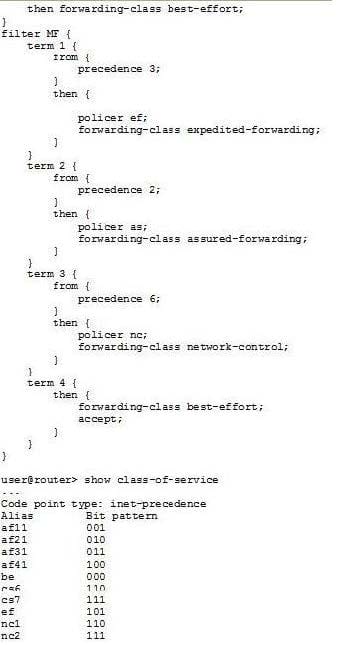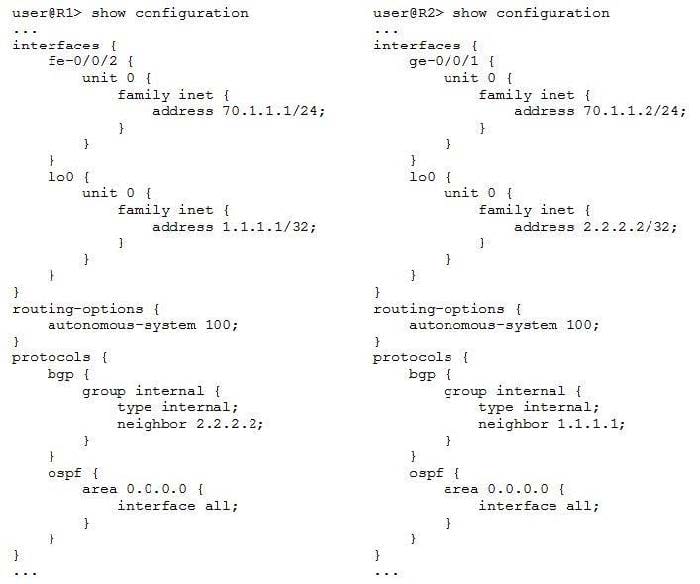JN0-694 Online Practice Questions and Answers
You observe that a router is using an unusually high amount of CPU cycles. You determine that continuous SPF calculations in OSPF are being performed.
What are two reasons for this problem? (Choose two.)
A. The wrong authentication keys between the OSPF neighbors are used.
B. The interface MTU is mismatched between the OSPF neighbors.
C. There are duplicate router IDs within the OSPF area.
D. An OSPF adjacency is flapping.
An end user on interface ge-0/0/1.0 is trying to receive a multicast stream for 232.0.0.1 sourced from but is not receiving it. You use the show igmp group command and do not see this group in the list. You enable traceoptions for IGMP and find the following IGMPv3 report from the end user's host: Jun 10 13:11:03.577641 RCV IGMP V3 Report len 16 from 192.168.1.13 intf ge-0/0/1.0 Jun 10 13:11:03.577984 Records 1 Jun 10 13:11:03.578027 Group 232.0.0.1, type IS_EX, aux_len 0, sources 0
Which configuration change is required to allow the group to be added in the router?
A. set routing-options multicast ssm-groups 232.0.0.1/32
B. set routing-options multicast asm-override-ssm
C. set protocols igmp interface ge-0/0/1.0 promiscuous-mode
D. set protocols igmp interface ge-0/0/1.0 group-limit 2
-- Exhibit -user@router> show ospf database
Area 0.0.0.1 Type ID Adv Rtr Seq Age Opt Cksum Len Router 172.24.255.1 172.24.255.1 0x800000d4 182 0x22 0x59f3 36 Router 172.24.255.2 172.24.255.2 0x800000d4 177 0x22 0x57f2 36 Router *172.24.255.4 172.24.255.4 0x800000dc 176 0x22 0x75fa 72 Network 172.24.124.2 172.24.255.2 0x80000007 177 0x22 0x7957 36 Summary 172.24.13.0 172.24.255.1 0x80000004 2370 0x22 0x3f62 28 Summary 172.24.23.0 172.24.255.1 0x80000002 471 0x22 0xdeb9 28 Summary 172.24.255.1 172.24.255.1 0x800000cb 2037 0x22 0x2bbb 28 Summary 172.24.255.2
172.24.255.2 0x800000cc 487 0x22 0x19ca 28 Summary 172.24.255.3 172.24.255.1 0x80000003 140 0x22 0xb2f9 28 OSPF AS SCOPE link state database Type ID Adv Rtr Seq Age Opt Cksum Len Extern *1.47.82.0 172.24.255.4 0x80000002 1037 0x22 0x4225 36 Extern *100.0.0.0 172.24.255.4 0x80000001 2643 0x22 0xfc88 36
user@router> show ospf neighbor Address Interface State ID Pri Dead
172.24.124.2 ge-0/0/1.0 Full 172.24.255.2 128 36
172.24.124.1 ge-0/0/1.0 Full 172.24.255.1 128 30
user@router> show ospf interface ge-0/0/1.0 extensive Interface State Area DR ID BDR ID Nbrs ge-0/0/1.0 PtToPt 0.0.0.1 0.0.0.0 0.0.0.0 2 Type: P2MP, Address: 172.24.124.4, Mask: 255.255.255.0, MTU: 1500, Cost: 1 Adj count: 2 Hello: 10, DeaD. 40, ReXmit: 5, Not Stub Auth type: None Protection type: None Topology default (ID 0) -> Cost: 1 user@router> show route protocol ospf table inet.0
inet.0: 11133 destinations, 11135 routes (11133 active, 0 holddown, 0 hidden) + = Active Route, - = Last Active, * = Both
224.0.0.5/32 *[OSPF/10] 1w0d 00:01:14, metric 1 MultiRecv -- Exhibit -
Click the Exhibit button.
Referring to the exhibit, why are the OSPF routes missing from the routing table for this router?
A. mismatching OSPF interface type with the neighbor
B. MTU mismatch with the neighbor
C. incorrect IP address configured on the interface
D. no Type 4 LSAs in the OSPF database
-- Exhibit -user@R1> show bgp neighbor 172.10.3.201 Peer: 172.10.3.201+54714 AS 64512 Local: 172.10.3.202+179 AS 64513 Type: External State: Established Flags: Last State: OpenConfirm Last Event: RecvKeepAlive Last Error: None Export: [ export ] Options: Local Address: 172.10.3.202 Holdtime: 90 Preference: 170 Local AS: 64513 Local System AS: 0 Number of flaps: 0 Peer ID. 10.247.194.254 Local ID. 10.247.24.6 Active Holdtime: 90 Keepalive Interval: 30 Peer index: 0 BFD. disabled, down Local Interface: ge-0/0/0.500 NLRI for restart configured on peer: inet-unicast NLRI advertised by peer: inet-unicast NLRI for this session: inet-unicast Peer supports Refresh capability (2) Restart time configured on the peer: 120 Stale routes from peer are kept for: 300 Restart time requested by this peer: 120 NLRI that peer supports restart for: inet-unicast NLRI that restart is negotiated for: inet-unicast NLRI of received end-of-rib markers: inet-unicast NLRI of all end-of-rib markers sent: inet-unicast Peer supports 4 byte AS extension (peer-as 64512) Peer does not support Addpath Table inet.0 Bit: 30000 RIB State: BGP restart is complete RIB State: VPN restart is complete Send state: in sync Active prefixes: 7 Received prefixes: 7 Accepted prefixes: 7 Suppressed due to damping: 0 Advertised prefixes: 30 Last traffic (seconds): Received 5 Sent 18 Checked 8 Input messages: Total 40 Updates 3 Refreshes 0 Octets 877 Output messages: Total 55 Updates 13 Refreshes 0 Octets 1764 Output Queue[2]: 0 -- Exhibit -
Click the Exhibit button.
A customer reports that BGP graceful restart is not working on R1. After a Routing Engine failover, R1 did not set the restart state bit in its Open message. The customer provides the BGP neighbor output shown in the exhibit.
Referring the exhibit, what is causing this problem?
A. BGP graceful restart is not enabled on R1.
B. BGP graceful restart is not enabled on the peer device.
C. The restart duration time is not configured on R1.
D. The restart duration time is not configured on the peer device.
-- Exhibit -protocols {
bgp {
group isps {
type external;
peer-as 13090194;
multipath multiple-as;
neighbor ;
neighbor ;
}
}
}
-- Exhibit -
Click the Exhibit button.
The exhibit shows the complete BGP configuration for a router. The network operator reports that both
peering sessions are up, but the router is not conducting per-flow load balancing over the connections to
these two peers.
What are two causes for this behavior? (Choose two.)
A. The forwarding-table export policy is not configured to cause per-flow load balancing.
B. The multiple-as parameter causes BGP to only choose multiple paths to different ASs, rather than multiple paths to the same AS.
C. The router has different IGP metrics to these BGP peers.
D. The BGP peers are not sending identical advertisements over the two sessions.
-- Exhibit -(MSTI 2 regional root: 16386.2c:6b:f5:3e:f8:01)
{master:0}
user@switch> show spanning-tree interface
Spanning tree interface parameters for instance 0
Interface Port ID Designated Designated Port State Role port ID bridge ID Cost
ge-0/0/6.0 128:519 128:519 16384.80711fbc 20000 BLK ALT ge-0/0/9.0 128:522 128:522
53248.2c6bf591a441 20000 FWD DESG ge-0/0/10.0 128:523 128:523 8192.80711fbe8110 20000 FWD
ROOT ge-0/0/12.0 128:525 128:525 49152.2c6bf53ef801 20000 BLK ALT
[...]
-- Exhibit -
Click the Exhibit button.
While troubleshooting an MSTP operation in your network, you see the output shown in the exhibit on one
of your switches. You know that the MSTI 2 regional root bridge ID is 16386.2c:6b:f5:3e:f8:01.
Which port is attached to the root bridge of MSTI 2?
A. ge-0/0/6
B. ge-0/0/9
C. ge-0/0/10
D. ge-0/0/12
There is a lot of traffic marked with IP precedence values af2l and af3l that ingresses the router. The af3l traffic should be using the expedited forwarding queue, but the traffic is much lower than expected and there are no drops seen on the egress interface.


Referring to the exhibit, what is causing the problem?
A. The assured forwarding queue has a strict high priority and is starving the expedited forwarding queue.
B. The expedited forwarding queue has a low priority value; therefore the traffic is not serviced.
C. The MF classifier is forwarding most of the af3l traffic to the best-effort queue.
D. The MF classifier is does not match on af3l and therefore the traffic is being dropped.
Interface ge-0/0/12 on Switch1 is connected to ge-0/0/12 on Switch2. You have configured both Switch1 and Switch2 to run MSTP. You see the CLI output shown in the exhibit.
What would cause this output?
A. Switch1 and Switch2 are configured with different autonomous systems.
B. Switch1 and Switch2 are configured with different bridge priorities.
C. Switch1 and Switch2 are configured with different names for their VLANs.
D. Switch1 and Switch2 are configured with different revision levels.
Referring to the exhibit, an administrator notices that the VLAN interface is not coming up. What would cause this problem? Click the Exhibit to see a larger version.

A. All member interfaces are down.
B. The unit number for the VLAN is misconfigured.
C. The subnet mask is incorrect.
D. All member interfaces are in access mode
You are configuring an IBGP peer between R1 and R2. The BGP neighbor cannot be established. Referring to the exhibit, which configuration change will resolve this problem?

A. Configure local-address on R1 and R2.
B. Configure local-as on R1 and R2.
C. Configure family inet-unicast on R1 and R2.
D. Configure router-id on R1 and R2.

